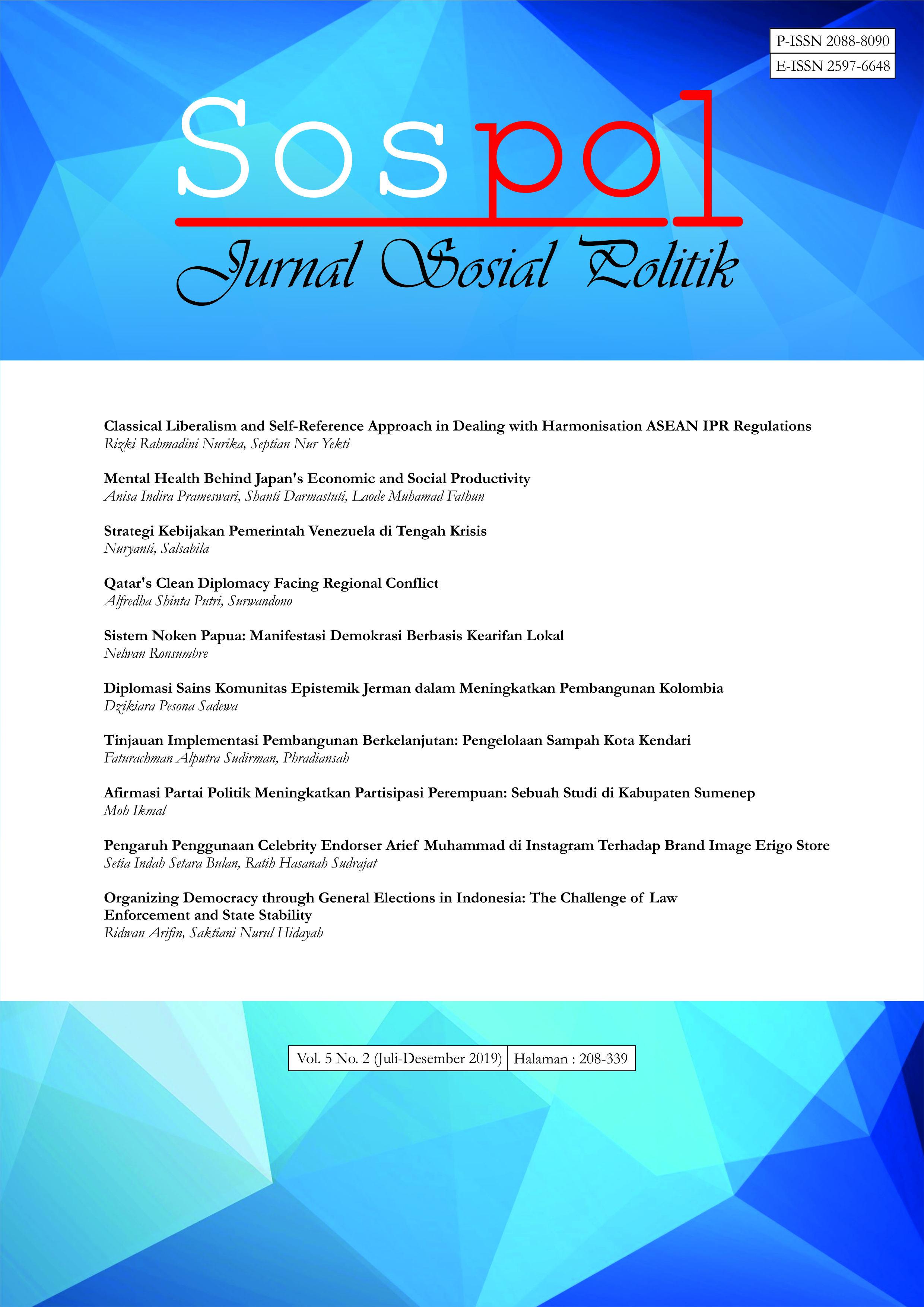Classical Liberalism and Self-Reference Approach In Dealing With Harmonisation ASEAN IPR Regulations
DOI:
https://doi.org/10.22219/sospol.v5i2.8256Keywords:
ASEAN, Intellectual Property Rights, WTOAbstract
ASEAN Economic Community (AEC) regulates the Intellectual Property Rights (IPR) in its relation with their economic activities. It was stipulated in the ASEAN Framework Agreement on Intellectual Property Cooperation in 1995. As the ASEAN member states are also the member of World Trade Organization (WTO), the principles of AEC have to be in harmony with the WTO principles. This paper analyzes the compliance of ASEAN IPR laws with the principles of Trade Related to Intellectual Property Rights (TRIPs) of WTO. Second, this paper analyzes the enforcement of those regulations in the member states, finding out whether there is implementation in the region that is different with the international principles or not. It is a part of qualitative research that used secondary data to complete the explanative analysis. Classical liberalism and self-reference criterion becomes theoretical framework of analysis. Classical liberalism promotes laissez-faire economics and private property in the means of production. Meanwhile, self-reference criterion refers to an unconscious reference to one’s own culture, values, knowledge, and experience as a basis for decisions. The result reveals that the ASEAN IPR regulations have different specific and special nature with the TRIPs, affected by the characteristics of the nations.
Downloads
References
References
Ainsworth, J. A. (2012). Integrating Methods and Strategies from Language Teaching and Business Studies in Languages for Specific Business Purposes Courses. Global Advances in Business Communication, 1(1), 1–18. Retrieved from https://commons.emich.edu/cgi/viewcontent.cgi?article=1002&context=gabc
Antons, C. (2006). Intellectual Property Law in Southeast Asia: recent legislative and institutional developments. Retrieved from https://warwick.ac.uk/fac/soc/law/elj/jilt/2006_1/antons/antons.pdf
ASEAN Secretariat. (2008). ASEAN Economic Community Blueprint. Retrieved from https://asean.org/wp-content/uploads/archive/5187-10.pdf
Barizah, N. (2017). The Development of ASEAN’s Intellectual Property Rights Law; from Trips Compliance to Harmonization. Indonesia Law Review, 7, 95–112. Retrieved from https://heinonline.org/HOL/Page?handle=hein.journals/indolawrev7&id=95&div=&collection=
Butt, S. (2009). Intellectual Property in Indonesia: A Problematic Legal Transplant (No. 09). Retrieved from https://papers.ssrn.com/sol3/papers.cfm?abstract_id=1401093
Degelsegger, A., Remøe, S. O., & Trienes, R. (2016). ASEAN Economic Community and intellectual property rights: an assessment of framework conditions for innovation. Retrieved from https://www.researchgate.net/publication/311069909
Endeshaw, A. (1999). Harmonization of Intellectual Property Laws in ASEAN. Journal of World Intellectual Property, 2(1). Retrieved from https://heinonline.org/HOL/LandingPage?handle=hein.journals/jwip2&div=3&id=&page=
Goode, R. (2014). Communication on European Contract Law. Retrieved from www.law.ox.ac.uk/profile/gooderon
Khine U, K. (2003). Protecting Intellectual Property in Myanmar. Asia Law – IP Review, (July/August).
Lake Tee, K. (2001). Copyright Law in Malaysia. In Malayan Law Journal (2nd ed., pp. 10–11). Kuala Lumpur: Butterworths Asia.
Loon, N.-L. W. (2003). Intellectual Property Law in Asia. Kluwer Law International, 291–306.
Rupert, J. (2011). Force Majeure: What is it and How Does it Relate to Business Continuity. Retrieved November 11, 2019, from https://avalution.com/force-majeure-what-is-it-and-how-does-it-relate-to-business-continuity/
Schultz, M. (2014). A free market perspective on intellectual property rights | American Enterprise Institute - AEI. Retrieved November 2, 2019, from https://www.aei.org/technology-and-innovation/intellectual-property/free-market-perspective-intellectual-property-rights/
Siegel, C. (2011). Classical Liberalism. California: Preservation Institute.
Silalahi, U. (2009). Metode Penelitian Sosial. Bandung: PT. Refika Aditama.
Smith, A. (2007). An Inquiry into the Nature and Causes of the Wealth of Nations (Vol. 2; N. W. Biggart, Ed.). London.
Thai Press. (2005, November 23). Vietnam: Assembly Adopts Laws on IP and e-transaction. Thai Press Report. Retrieved from http://www.thailand4.com/
Varner, I. I., & Varner, K. (2014). The Relationship Between Culture and Legal Systems and the Impact on Intercultural Business Communication. Global Advances in Business and Communication Conference & Journal, 3(1). Retrieved from https://commons.emich.edu/gabc/vol3/iss1/3/
WTO. (1994). TRIPS Agreement (as amended on 23 January 2017). Retrieved November 2, 2019, from https://www.wto.org/english/docs_e/legal_e/31bis_trips_01_e.htm
WTO. (2019). The Uruguay Round. Retrieved November 2, 2019, from https://www.wto.org/english/thewto_e/whatis_e/tif_e/fact5_e.htm
Downloads
Published
How to Cite
Issue
Section
License
Authors who publish with this journal agree to the following terms:
- Authors retain copyright and grant the journal right of first publication with the work simultaneously licensed under a Creative Commons Attribution-ShareAlike 4.0 International License that allows others to share the work with an acknowledgement of the work's authorship and initial publication in this journal.
- Authors are able to enter into separate, additional contractual arrangements for the non-exclusive distribution of the journal's published version of the work (e.g., post it to an institutional repository or publish it in a book), with an acknowledgement of its initial publication in this journal.
- Authors are permitted and encouraged to post their work online (e.g., in institutional repositories or on their website) prior to and during the submission process, as it can lead to productive exchanges, as well as earlier and greater citation of published work (See The Effect of Open Access).

This work is licensed under a Creative Commons Attribution-ShareAlike 4.0 International License.



















